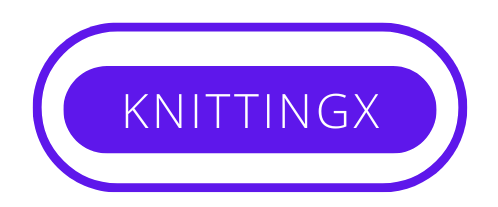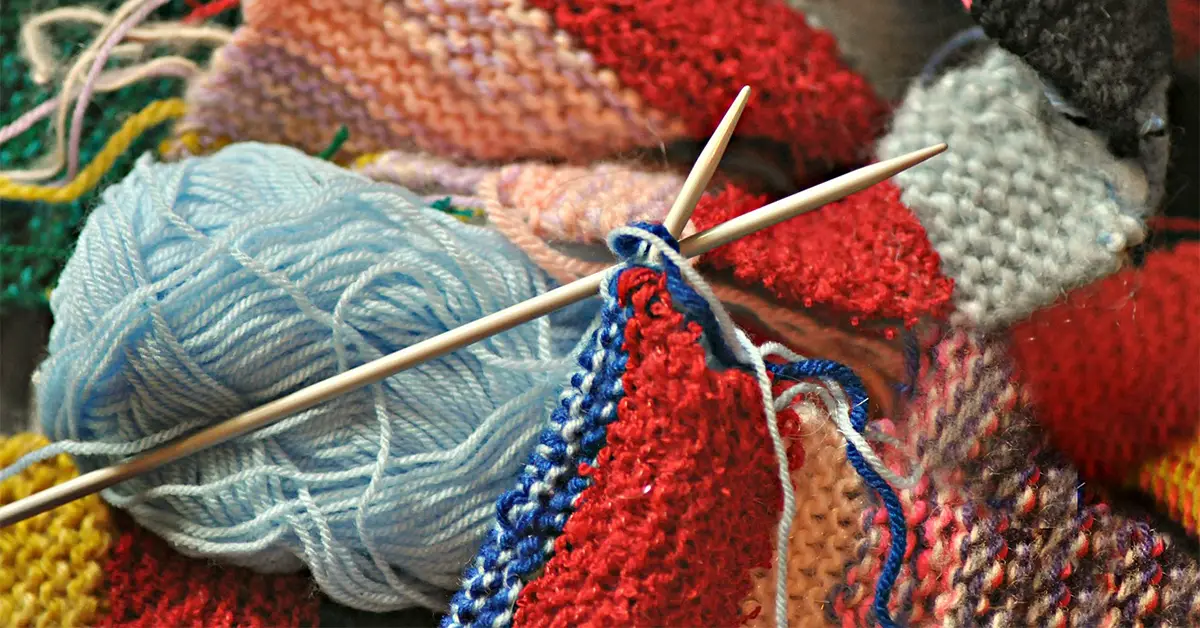To measure knitting needles, you need a gauge ruler that features the metric system on one side of it. It is usually a little metal ruler with a L-shaped hole in it, that is used to measure the diameter of your needle. All you need to do is place the needle between the hash marks on the ruler. Then, count the lines it falls between.
Nowadays, most knitting needles on the market are designed in a way to make it easy for you to measure what size they are. The straight type of needles normally has a knobby kit located at the end with US or UK numbers and the metric measurement.
In this article, we are going to look at various types of knitting needles, how they are measured with sizes and materials, and DIY ideas to tell sizes apart.
Knitting Needles Sizes
| Millimeter Range | U.S. Sizes Range |
| 2.25mm | 1 |
| 2.75mm | 2 |
| 3.25mm | 3 |
| 3.5mm | 4 |
| 3.75mm | 5 |
| 4mm | 6 |
| 4.5mm | 7 |
| 5mm | 8 |
| 5.5mm | 9 |
| 6mm | 10 |
| 6.5mm | 10 ½ |
| 8mm | 11 |
| 9mm | 13 |
| 10mm | 15 |
| 12.75mm | 17 |
| 15mm | 19 |
| 19mm | 35 |
| 25mm | 50 |
Numbers or letters may vary.
The circular needles are usually a little complicated. Most times, the size is usually published on the needed, close to the point where the circular part joins the needle part. Besides, this is achievable only if the needle is not part of an interchangeable set. However, if the needle is part of an interchangeable set, there will marked spaces for each sizes on your storage case. But the truth is that the needles will not indicate their sizes themselves.
Antique needles, handmade needles, double-pointed needles, and other needles made of some special materials will not have size marking. Sometimes knitting needles are initially marked but wears off with daily use and with time.
Knitting needles come in different materials, styles, and sizes, and it can be daunting and time-consuming to know which one to use at the right time. Whether you’re expanding your collection or buying your first set of knitting needles, this article is here to help!
The gauge of your knitting is determined by the size or diameter of your knitting needles. Nevertheless, these needles also come in different lengths which solely determines the size of the project you can create on the needles.
We have five basic types of knitting needles;
1. Circular needles
2. Interchangeable needles
3. Cable needles
4. Straight needles
5. Double-pointed needles
How important Is A “Point”
The points of the of the needles make a big difference, no matter the type of knitting needle you own. If you want to accurately work with fine yarn, get needles with sharp points. However, needles with rounded point are perfect for kids and bulky yarn. Sometimes it’s all about your preferences, while other times you’ll need a specific type of knitting needles. Check out what’s available, then find the one that best suits your needs.
Circular Needles
Circular Needles are best suited for a large knitting project. They have flexible cord that unite them, making them look like one long knitting needle. You can form circular needles with interchangeable pieces or you can purchase fixed circular needles, meaning the cord and the ends are completely joined.
Materials And Size
The most common materials used for circular needles parts are bamboo, plastic, aluminum, and steel.
Most circular needles come in longer and shorter lengths, but they also range from 16 to 48 inches long. The cord also very in thickness. Coated steel and nylon are the common cord portion. Some circular needles have a memory or hold their shape. Most knitters find such needles awkward to work with because it feels like it has its own mind. So check out for memory-free circular needles to avoid such
What Are Circular Needles Best Used For?
Circular needles are primarily used for project done in rounds such as hats, sweaters, cowls, shawls, or even the intricate socks with the magic loop method.
Also, these needles can be used for flat projects. All you need to do is use back and forth method as usual, then transferring the work from one end to another. This method is essentially useful when working on larger projects like blankets or shawls which does not work well on straight needles.
Interchangeable Needles
Whether you want the flexibility of circular needles in different sizes or the option to use them in lots of ways, the interchangeable needles are a great option for you. Just like circular needles, interchangeable needles have a flexible cord and a firm tip, which enables you to change out the needle cord lengths and sizes. You can use them like straight needles by connecting the needles to cords and attaching caps at the ends. Interchangeable needles come as individual pieces or in sets. Some connect with a tiny screw-on piece, while others use different mechanisms.
The major benefit of buying interchangeable needles set is that all the required pieces are in one case, although it can be costlier. If you need a small range of sizes or if you want to grow your knitting collection slowly, buying a separate piece will be a better choice for you.
Cable Needles
Whenever you see a rounded, hook-like needle, or perhaps even a small, oddly shaped double-pointed needle, that’s a cable needle. These needles are used to hold stitches when creating knitted cables. Although it might be very possible that cables can be knitted without using a cable needle but the tool are just handy for keeping stitches accurate while moving them around.
Materials And Sizes
This special tool can be found in plastic, glass, metal, bamboo, and even wood. Why not choose one that’s beautiful and fun to work with?
There needles are only a few inches long and they are designed with fewer diameter because they hold a few stitches for a small period of time. It is recommended that you should choose cable needles that have same size or even smaller that the traditional needles for your knitting project.
Straight Needles
Most people picture straight needles while thinking of knitting needles. Straight needles normally come in sets of two, and each has a stopper or knob at one end and a point at one end. If you’re a beginner, straight needles are a perfect option for your first set of needles, as they are easy to use an user-friendly.
Materials And Sizes
The materials used for straight needles include aluminum, bamboo, wood, plastic, and steel. Each material vary with each manufacturer, but also have their pros and cons.
The most common straight needles sizes ranges from nine to fourteen inches long, but you may find longer or shorter needles too.
Straight Needles
When most people think about knitting needles, they picture straight needles. These come in sets of two, and each has a point at one end and a knob or stopper at the other. This type is great for your first set of needles, as they are straightforward and easy to use.
What Are Straight Needles Best Used For?
Since they hold all your stitches, they are best suited for smaller project that you can work flat. This projects include scarves, Afghan Square, washcloth, or even sweaters.
Double-pointed Needles (also called DPNs)
Double-pointed needles are another tools used to knit smaller projects in the round.
They are short straight needles that usually come in set of four to six needles and have points at both ends. Some double-pointed needles have either a flexible portion in the middle or a ben.
Materials And Sizes
Double-pointed needles comes in the same materials as other needles.
These needles range in size, from five to eight inches long. If you want to create tiny projects like a baby socks, go for the shorter needles. However, if you to make tubular shaped projects like hats, get the longer ones.
What Are Double-Pointed Needles Best Used For?
Most knitters use double-pointed needles for making socks, but these needles can also be used for knitting hats, kittens gloves, and shawls. DPNs are also perfect for knitting sweater sleeves or small toys.
How Knitting Needles Are Measured
To measure knitting needles, you need a gauge ruler that features the metric system on one side of it. It is usually a little metal ruler with a L-shaped hole in it, that is used to measure the diameter of your needle. All you need to do is place the needle between the hash marks on the ruler. Then, count the lines it falls between.
The essential tool you need to measure the size of your knitting needle is known as a gauge ruler. To measure your knitting needles, slide the needle into on of the L-shaped holes in the gauge ruler. Now, keep trying different needles until you find the one that it will fit through without much wiggle room. That’s the size of your needle. It is recommended that you get a needle gauge or gauge ruler manufactured by the same company that made your knitting needles. This is because there are slight differences among manufacturers.
Conclusion
We have come to the end of this lengthy article, we hope you were able to learn new things about how knitting needles are measured. If you have any questions, feel free to ask.

